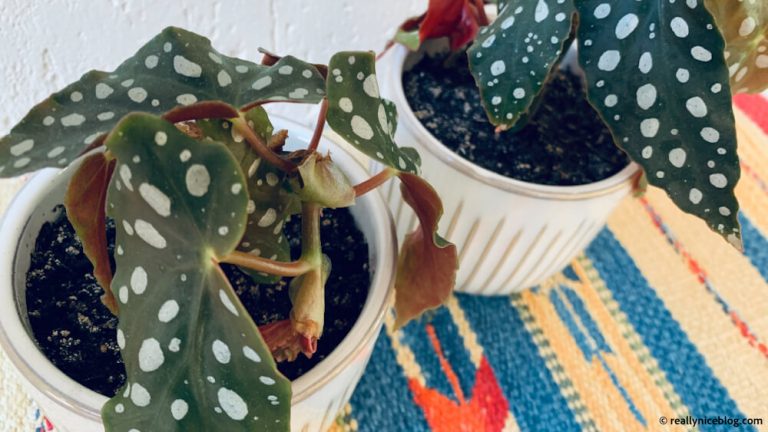Begonia maculata or polka dot begonia is one of those houseplants with exotic and very instagramable look. No wonder polka dot begonia so often appears on the trendy indoor plants lists. Looking good, growing fast and easy to care for – sounds like a perfect combo for a houseplant.
Once you set the right balance, Begonia maculata is one of the easiest plants to grow. This guide will help you take good care of your spotted begonia. It has the basic care tips for making sure that your Begonia maculata is thriving. Essentially, light, water, some plant food and a nice space to grow is all your indoor plants really need. In addition, I will share my polka dot begonia story. Spoiler alert: it almost died but now I have two cute baby begonias.
About Begonia maculata
The trademark look of polka dot begonia makes this houseplant very easy to recognise. Its angel wing shaped, deep olive green color leaves have white, lustrous round spots. Pair this with the fancy looking crimson red undersides. The retro style foliage gracefully sits on the bamboo-like cane stems. In bloom time, Begonia maculata charms with its petite white or soft pink blossoms (still waiting to see them on my plants).

Begonia maculata Care Guide
Light
The fact that Begonia maculata was first discovered in Brazil suggests that this plant likes when it is nice and sunny. Ideally, place your spotted begonia where it will receive plenty of bright but indirect light. My plants seem to enjoy the east-facing window. Keep the polka dot begonia away from direct sunlight as it may burn and damage its beautiful leaves.
Water
Watering Begonia maculata once a week should do the trick. As for most indoor plants, make sure that excess water is fully drained. Soggy soil is a no-no. Overwatering may quickly evolve into a root rot and no one wants that. To avoid this risk, I find it better to water my polka dot begonias less. When the leaves start to look a tiny bit droopy and the top soil is dry, the plant needs a drink.
Soil
Nothing fancy – I use simple soil for indoor plants. As the right amount of water is very important for polka dot begonia, try mixing in some perlite. It will loosen up the soil, allow more air for the roots and improve water drainage.
Fertilizing
To feed my baby begonias, now I use universal, water-soluble plant food. The small bottle of fertilizing powder takes up very little space and is convenient to store. You only need to mix it with water and water your plant as usually. Generally, it is recommended to fertilize Begonia maculata on a monthly basis during spring and summer, when the plant is growing.
Temperature & Humidity
In short – room temperature is great (think around 68°F or 20°C). As polka dot begonia naturally grows in subtropical and tropical climates, it means this plant likes high humidity. To ensure that the air meets the houseplant needs, you may use a professional plant humidifier or a very simple trick such as placing a glass of water next to your begonia. I placed begonias next to our kitchen sink and my theory is that they get enough humidity form us washing the dishes.
How I Almost Killed My Begonia But Now I Have Two
Polka dot begonia came into my life as a birthday gift. I wanted this plant in my collection for a long time and was so thrilled! Knowing that Begonia maculata grows quite fast, I was plotting to take good care of it, propagate much and turn our home into a little begonia jungle.
Of course, the opposite happened. It seemed as if my begonia was intimidated by my excitement. Leaves were falling off fast. Repotting, changing light and watering less did not help. With every day, it got worse and the plant was clearly dying.
I saved two stems that still showed some signs of life and put them in a glass of water. I changed the water every now and then but in general, I tried to give some peace for the remnants of the Begonia maculata. Several months passed and they started growing tiny roots and baby leaves. I felt both excited and a little worried that after transferring to soil, my begonias might die again. But guess what – now they are doing great!
There are two baby begonias on my kitchen window and indeed, they are growing fast. It may sound silly but every time I look at them, they remind me that one should never give up. To me, Begonia maculate became a symbol of surviving no matter what.
To add, I have another theory on why it did not work out from start. The initial plant may have been sick. Its leaves had brownish spots that were spreading. I did my research, tried different things and could not find a good solution. Ever experienced something like that?

